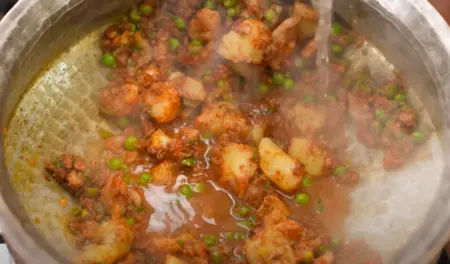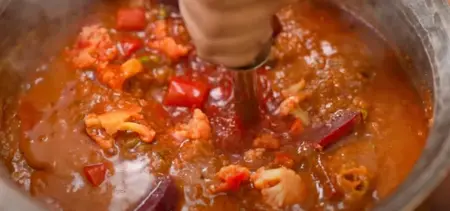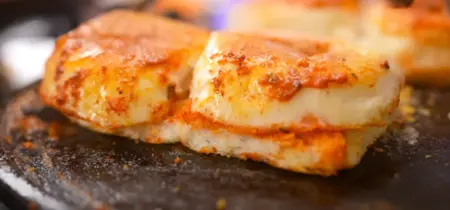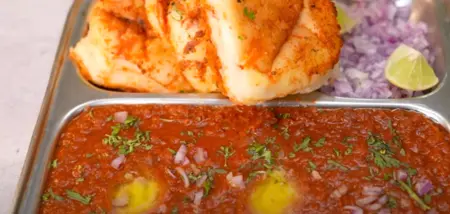
Pav Bhaji Recipe

40

5

10
Introduction
Let me take you back to the bustling streets of Mumbai, where I first encountered the mouthwatering aroma of Pav Bhaji wafting through the air. It was a hot summer day, and after a long day of exploring the city, I stumbled upon a street vendor serving up steaming hot plates of Pav Bhaji. With each bite, I was transported to a world of flavor - the buttery pav complemented the spicy and tangy bhaji perfectly. From that moment on, Pav Bhaji became a quintessential part of my culinary journey, reminding me of the vibrant and diverse flavors of Mumbai.
Recipe of Pav Bhaji
Ingredients:
Ingredients of Pav Bhaji
-
1 cup Cauliflower
-
1/2 cup Beetroot
-
1 cup Winter carrots
-
2 tbsp Salt
-
Water, as required
-
5 tbsp Butter
-
1 cup Onion, chopped
-
1 cup Tomato, chopped
-
1/2 cup Green capsicum, chopped
-
1/2 cup Green peas
-
1 tbsp Coriander, chopped
-
1 tbsp Jeera (Cumin) powder
-
1 tbsp Kashmiri chilli powder
-
1/2 tbsp Ghati masala (or Pav Bhaji masala)
-
1 tbsp Coriander powder
-
3-4 Potatoes, boiled & peeled
-
1 tbsp Oil
-
8-10 Ladi pav (bread rolls)
Instructions:
Instructions of Pav Bhaji
Step 1: Pressure Cook the Vegetables In a pressure cooker, add cauliflower, winter carrots, beetroot, 2 tbsp salt, and enough water to cover the vegetables. Pressure cook for 3-4 whistles until the vegetables are soft.
Step 2: Sauté the Onions Heat a thick-bottomed pan and add butter. Once the butter melts, add chopped onions and sauté until translucent.
Step 3: Add Spices and Tomatoes Add jeera (cumin) and continue to sauté until aromatic. Then, add chopped tomatoes and cook until they turn soft and mushy.
Step 4: Add Vegetables and Masala Add green peas to the pan and sauté for a few minutes. Mash the boiled potatoes and add them to the pan along with salt, jeera powder, Kashmiri chilli powder, coriander powder, and ghati masala. Mix well and add a little water to adjust the consistency.
Step 5: Mash the Vegetables Mash all the vegetables using a potato masher until they are well combined. Add pav bhaji masala and red chilli & garlic paste. Cook for an additional 3-4 minutes.

Step 6: Combine and Cook Once the pressure-cooked vegetables are ready, add them to the pan and mash them thoroughly into the mixture. In a separate thick flat pan, heat oil and water. Add the prepared pav bhaji mixture, butter, and chopped coriander. Cook for a minute, stirring continuously.

Step 7: Toast the Ladi Pav Toast the ladi pav on another pan until they are lightly crisp and golden brown.

Step 8: Serve Serve the hot pav bhaji with toasted ladi pav, some chopped onions, and a lemon wedge on the side.

Enjoy your delicious homemade pav bhaji!
About Pav Bhaji
Pav Bhaji is a popular street food dish originating from the streets of Mumbai, India. It consists of a spicy vegetable mash (bhaji) made from a medley of vegetables such as potatoes, tomatoes, peas, cauliflower, and bell peppers, seasoned with a blend of aromatic spices. The bhaji is served with buttered and toasted pav (bread rolls) and garnished with chopped onions, cilantro, and a squeeze of lime juice. Pav Bhaji is beloved for its bold flavors, comforting texture, and vibrant colors, making it a favorite among locals and tourists alike.
Cooking Tips
- Use Fresh Ingredients: Opt for fresh and ripe tomatoes, potatoes, and other vegetables to enhance the flavor of the Pav Bhaji.
- Mash Thoroughly: Ensure that the vegetables are thoroughly mashed to achieve a smooth and creamy texture for the bhaji.
- Adjust Spice Levels: Customize the spice level according to your preference by adjusting the quantity of green chilies or chili powder.
- Butter and Masala: Generously use butter while cooking the bhaji for an authentic flavor, and don't forget to add pav bhaji masala for that signature taste.
- Serve Hot: Serve the Pav Bhaji piping hot with buttered pav for the best experience.
Pairing Guide
Pav Bhaji pairs well with:
- Pav: Serve with buttered and lightly toasted pav (bread rolls) for a classic combination.
- Onions and Lemon: Garnish with finely chopped onions and a squeeze of fresh lemon juice for added freshness.
- Pickles: Enjoy with tangy and spicy mango pickle or lemon pickle for an extra kick of flavor.
Frequently Asked Questions about Pav Bhaji
-
Is Pav Bhaji a healthy dish?
- While Pav Bhaji is packed with vegetables, it is often cooked with butter, making it high in calories. However, you can make it healthier by using less butter and opting for whole wheat pav.
-
Can I make Pav Bhaji without butter?
- While butter adds richness and flavor to Pav Bhaji, you can use alternatives such as ghee or oil for a lighter version.
-
What is Pav Bhaji masala, and where can I buy it?
- Pav Bhaji masala is a blend of spices specifically used to flavor Pav Bhaji. It is readily available in most grocery stores or online.
-
Can I customize the vegetables in Pav Bhaji?
- Yes, you can customize the vegetables in Pav Bhaji according to your preference. Some common additions include carrots, beans, and bell peppers.
-
Can I make Pav Bhaji without onions and garlic?
- While onions and garlic add flavor to Pav Bhaji, you can omit them if preferred. Adjust the seasoning accordingly to suit your taste.
-
Can I freeze leftover Pav Bhaji?
- Yes, you can freeze leftover Pav Bhaji in an airtight container for up to 2-3 months. Thaw and reheat before serving.
-
What is the best time to enjoy Pav Bhaji?
- Pav Bhaji is perfect for any time of the day, whether it's a quick lunch, evening snack, or even dinner.
-
Can I use store-bought pav instead of making it at home?
- Yes, you can use store-bought pav instead of making it at home for convenience.
-
What is the origin of Pav Bhaji?
- Pav Bhaji originated in the streets of Mumbai, India, as a quick and flavorful snack for textile mill workers.
-
Can I make Pav Bhaji ahead of time for a party?
- Yes, you can prepare the bhaji ahead of time and reheat it before serving. Toast the pav just before serving for the best taste and texture.
